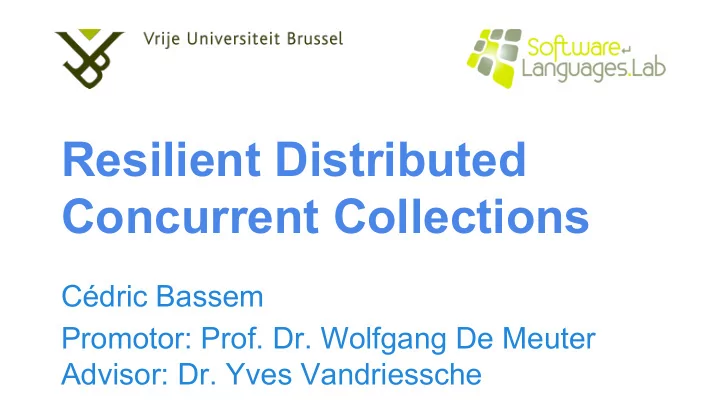

Resilient Distributed Concurrent Collections Cédric Bassem Promotor: Prof. Dr. Wolfgang De Meuter Advisor: Dr. Yves Vandriessche 1
Evolution of Performance in High Performance Computing Exascale = 10 18 Flop/s Petascale = 10 15 Flop/s (source: http://www.top500.org/statistics/perfdevel/) 2
Evolution of Failures in HPC Main Source: Hardware Faults (~ 50%) SMTTI = System Mean time to interrupt In Exascale SMTTI < 30 min Source: Franck Cappello (2009) 3
Resilience Resilience = Fault Tolerance Avizienis et al. (2004) “The collection of techniques for keeping applications running to a correct solution in a timely and efficient manner despite underlying system faults” Snir et al. (2014) 4
Coordinated Checkpoint/Restart 5
Asynchronous Checkpoint/Restart 6
Requirements for Asynchronous Checkpoint/Restart Reasoning about state: Self-aware, execution frontier Safe restart: Deterministic computation Data race free: Monotonically increasing state 7
Resilience in CnC Vrvilo, N. (2014). Asynchronous Checkpoint/Restart for the Concurrent Collections Model (Unpublished master’s thesis). Rice University, Houston, Texas USA. Focused on shared memory CnC runtimes CnC Properties: ● Dependency graph ● Provable deterministic computation ● Single assignment data 8
The Concurrent Collections Model Checkpoint env 0 Tags 0 1 1 2 2 Fibs Results 9
The Concurrent Collections Model Checkpoint Tags 0 0:0 0 1 2 1 2 Fibs Results 0 0:0 10
The Concurrent Collections Model Checkpoint Tags 0 0:0 0 1 1:1 2 1 2 Fibs Results 0:0 1 1:1 11
The Concurrent Collections Model Checkpoint Tags 0 0:0 0 1 1:1 2 1 2 Fibs Results 0:0 1:1 2 12
The Concurrent Collections Model Checkpoint Tags 0:0 0 1:1 1 2 Fibs Results 13
The Concurrent Collections Model Checkpoint Tags 0:0 0 1:1 1 2 Fibs Results 14
The Concurrent Collections Model Checkpoint Tags 0:0 2 0 1:1 1 2 Fibs Results 0:0 1:1 2 2:1 15
The Concurrent Collections Model Checkpoint Tags 0:0 2 0 1:1 1 2 Fibs Results env 0:0 1:1 2:1 2:1 16
Proof of Concept Implementation Goal : Assessing the viability of Asynchronous C/R in distributed memory CnC runtimes Runtime: Intel(R) Concurrent Collections for C++ (Architect: Frank Schlimbach) Resilience Flavour : ● Dedicated checkpoint node ● Fine grained updates ● Uncoordinated restart 17
Dedicated Checkpoint Node & Fine grained Updates Updates contain: Node data instances consumed Checkpoint data instances produced Node Node control instances produced producers consumers Node 18
Restart 2 Restart simulation ➜ No fault tolerant MPI Node Uncoordinated ➜ Step duplication 1 3 Node Node Node 4 19
Memory Management in CnC Non-trivial: data accessed by dynamic steps One solution: get-counting method int getCountFib( FibTag t ) { if ( t > 0 ) { return 2; else { return 1; } } 20
Solution Extra bookkeeping in checkpoint: ➢ Consider steps only once when lowering get counts ○ Hashmap of considered steps ➢ Never re-add removed data instances ○ Marking data as removed 21
Modelling Overhead (Tw/Ts) Coordinated Checkpoint/Restart (Daly, 2006) Asynchronous Checkpoint/Restart 22
Evaluating Asynchronous Checkpoint/Restart 23
Benchmarks - Goals Assessing overhead factor (φ): Ok if high Method: Measure w/o resilience = Solve time (Ts) Measure with resilience = Wall clock time (Tw) Overhead factor = Tw/Ts Assessing restart time (Tr): Should be low Method: Measure time needed to calculate the restart set 24
Number of Steps Fibonacci Mandelbrot Overhead factor (φ): Increases with number of steps 25
Restart Time Restart Time (Tr): Low Optimization: Shifting some of the complexity to the overhead factor Fibonacci: Restart Time 26
Future Work Distributed Checkpoint: Checkpoint ➢ Overhead high but constant ➢ Restart time? Tag-only logging: ➢ Less communication ➢ Complex restart 27
Conclusion Asynchronous C/R distributed memory CnC runtime ➢ Analyzing different cases ➢ Proof of concept implementation Asynchronous C/R is viable for systems with low SMTTI ➢ Model ➢ Proof of concept implementation 28
References Daly, J. T. (2006). A Higher Order Estimate of the Optimum Checkpoint Interval for Restart Dumps. Future Generation Computer Systems, 22(3), 303–312. Avizienis, A., Laprie, J., Randell, B., & Landwehr, C. E. (2004). Basic Concepts and Taxonomy of Dependable and Secure Computing. IEEE Transactions on Dependable and Secure Computing, 1(1), 11–33. Snir, M., Wisniewski, R. W., Abraham, J. A., Adve, S. V., Bagchi, S., Balaji, P., . . . Hensbergen, E. V. (2014). Addressing Failures in Exascale Computing. International Journal of High Performance Computing Applications, 28(2), 129–173. Franck Cappello (2009). Fault Tolerance in Petascale/ Exascale Systems: Current Knowledge. International Journal of High Performance Computing, 23(1) , 212-226. Vrvilo, N. (2014). Asynchronous Checkpoint/Restart for the Concurrent Collections Model (Unpublished master’s thesis). Rice University, Houston, Texas USA. 29
Recommend
More recommend